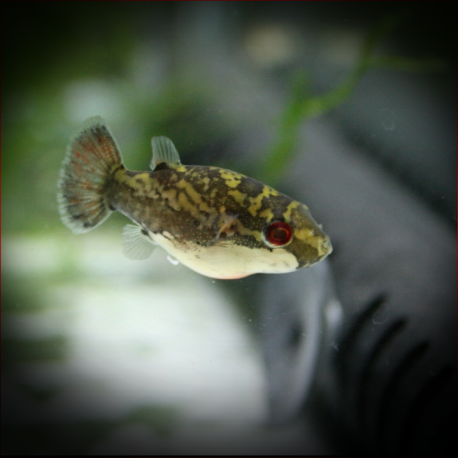More info
Datasheet
| Minimum Tank Size | 60 litres / 15.85 US gallons |
| Maximum Size | 6.0cm / 2.36inches |
| Temperature | 20°C / 68.00°F - 28°C / 82.40°F |
| Hardness | 1.01dgH / 18ppm - 12.05dgH / 215ppm |
| pH | 5.0-7.5 |
General Description
Carinotetraodon Lorteti, commonly known as Redeye Puffer, is a member of the Tetraodontidae family within the order Tetraodontiformes. These unique fish lack true teeth, instead possessing four fused toothlike structures that grow continuously. They are characterized by their ability to inflate their bodies when stressed or threatened, a morphological adaptation that allows them to swim through a combination of pectoral and median fin undulations. Puffer flesh is toxic due to the presence of tetrodotoxin or saxitoxin, depending on the species, geographic area, and time of year.
Aquarium Setup
Redeye Puffers require a well-decorated aquarium with driftwood roots or branches and plenty of aquatic plants, including floating varieties for shade. The addition of dried leaf litter helps create a natural environment and can serve as a food source for fry. Water conditions should be maintained at a hardness of 18-215ppm, a pH of 5.0-7.5, and a temperature range of 20-28°C. It's crucial to avoid strong water flow and conduct regular small water changes due to the species' sensitivity to deteriorating conditions.
Behaviour
Unsuitable for community tanks, Redeye Puffers are known to exhibit territorial aggression, especially in smaller aquariums. They have a tendency to bite the fins of tankmates, making it best to keep them alone unless the tank is properly set up with sufficient space to accommodate a group. Males display distinctive dorsal and ventral keels and show intensified color patterns during courtship.
Feeding and Diet
To maintain their toothlike structures, Redeye Puffers need a diet of shelled invertebrates like snails, small crab legs, and cockles, along with aufwuchs and other live or frozen foods such as chironomid larvae and Artemia. While dried products should not be the main food source, pelleted foods with a hard consistency can be beneficial for their dental health.
Reproduction & Dimorphism
Breeding Redeye Puffers in captivity is possible, with males taking on the responsibility of guarding the brood. Courtship involves intensified color patterns and displays of the dorsal and ventral crests. Female puffers have a reticulated color pattern on the body and caudal fin, while males possess a uniformly colored body and caudal fin. Semi-adhesive eggs are deposited among aquatic vegetation, with fry hatching within 60-72 hours.
Habitat and Distribution
In the wild, Carinotetraodon Lorteti inhabits slow-moving to standing water in shady forest streams, minor tributaries, and floodplains in regions such as the lower Mekong basin in Thailand, Vietnam, and Cambodia. They may also be found in smaller river systems within the Chao Phraya watershed in central Thailand. The species thrives in environments with aquatic or dense riparian vegetation, fallen leaves, and branches covering the substrate.

